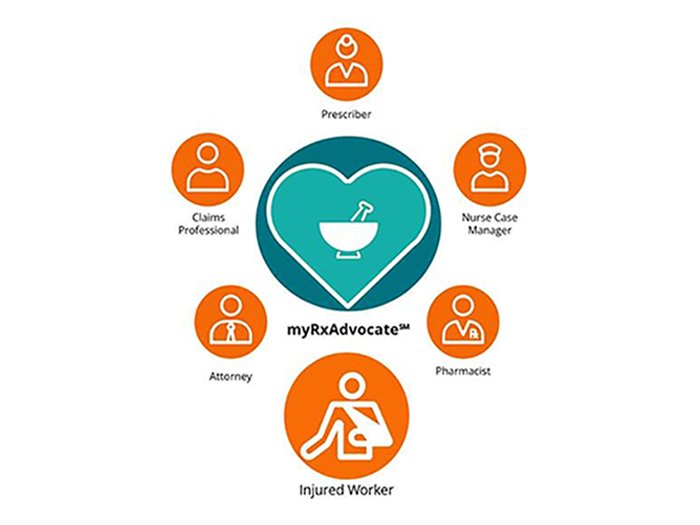Sponsored: myMatrixx
How a Data-Driven Clinical Pharmacy Program Drives Better Results for Everyone in Workers’ Comp

Patient advocacy has become a buzz-phrase in the world of workers’ compensation. Employers, claims professionals and care providers will all talk about how they put the injured worker first.
Historically, pharmacists involved in workers’ compensation have had difficulty filling the role of patient advocate — or at least convincing injured workers that they were, in fact, working in their best interests.
“In worker’s compensation, there are so many competing interests that sometimes it is difficult to be a patient advocate. Not from lack of desire or skill or anything else, but that a patient’s perception of your activities is not the same as it is in other areas of healthcare,” said Phil Walls, Chief Clinical Officer, myMatrixx.
“When we intervene to persuade prescribers to look at more appropriate alternatives, it can be perceived by a patient as keeping them from getting the medication their doctor had prescribed. There was an assumption that the doctor is always right, so why would you interfere?”
In reality, pharmacy decisions save lives. When the right calls are made clinically, everyone wins.
“The actions of the clinical pharmacist aren’t about denial of access, they’re about appropriate therapy choices,” said Cliff Belliveau, Vice President of Business Intelligence at myMatrixx.
When pharmacy benefit managers (PBMs) place the injured worker at the center of care, it works in the best interests of all involved — case manager, adjuster, physicians, carriers, employers and even attorneys — because the end result is a better clinical outcome, which generally translates to faster return to work, improved quality of life and lower overall cost. Everyone, in the end, wants the same result.
myMatrixx myRxAdvocateSM, myMatrixx’s clinical pharmacy program, is premised on the belief that clinical pharmacists in workers’ comp are well-positioned to advocate for all parties.
The program is designed to move appropriate interventions earlier in the claim process, so that mistakes can be avoided rather than fixed later. The belief is that early intervention is the key to ensuring appropriate care, better outcomes, and therefore a better result for everyone involved. Here’s how it works:
1) Interventions are truly data driven

Phil Walls, Chief Clinical Officer, myMatrixx
myMatrixx’s Clinical Analysis Results Engine (CARE) brings together disparate data to determine the appropriateness of a prescribed drug regimen, generating a holistic risk score.
“The higher the score, the greater the risk that patient has for some type of pharmaceutical misadventure,” Walls said. “That then allows us to focus resources on the high-risk patients first.”
Importantly, the data is left alone to do its job. The intervention process begins when the data — not a pharmacist — indicates a problem. This eliminates the introduction of personal bias. If a team is only looking for cases involving opioids, they are bound to find them, but at the same time they could be missing other high-risk cases involving more innocuous drugs like NSAIDs.
“The data guides us. We don’t guide the data. We are able to look at all our patients and determine what problems exist. It could be opioids. It could be topicals. Or it could be drugs that most people don’t worry about, like benzodiazepines,” Belliveau said.
2) Analytical systems are expert and scalable
Pharmacists undergo years of schooling and training. They have deep knowledge and expertise that is necessary to redirect cases threatening to go off course — but that knowledge is hard to scale.
The reason CARE acts as a trusted guide to intervention decision-making is because it was built to think like a pharmacist first. Its focus is on evidence-based clinical pharmacy guidelines above factors like cost.
“PharmDs can look at a drug and know exactly that it’s the wrong drug for the patient. They have the education and experience to make that determination,” Belliveau said. “What we’re doing is basically taking the brain work of these clinical pharmacists and putting that in a computer, because we can scale that much more easily than hiring several PharmDs.”
The system is therefore able to do some of the clinical legwork that a pharmacist normally has to do, which speeds up the process and makes earlier intervention more feasible.
CARE was also developed in house, specifically tailored to the considerations of workers’ comp claims. That’s important because buying an outside system generally means buying an outside perspective as well. Customizing an engine after it’s already been designed to work a certain way is a much more onerous task than building one from scratch.
3) Reporting on more than financial outcomes

Cliff Belliveau, Vice President of Business Intelligence, myMatrixx
Traditionally, clinical pharmacy results are reported in terms of financial savings.
“There’s so much overutilization of drug therapy, that when a clinical pharmacist gets involved, their recommendation to prescribers is almost always, ‘Decrease the dose, decrease the quantity, discontinue a drug altogether.’ And the easiest way to measure that has always been in money saved,” Walls said.
But outcomes encompass so much more than the financials of a claim. Dollars saved doesn’t necessarily mean a pharmacy-ordered change actually helped a patient.
The impact of interventions must be measured as well—did the prescriber comply with the intervention and change the drug therapy, and patient show measurable clinical improvement as a result? When the answer to these questions is yes, then we have taken a huge step to allay the injured patient’s fear that our actions truly present advocacy.
CARE helps to measure the impact by assigning patient a risk score based on factors like their injury, age, the phase of the claim (whether it’s new or a legacy case) in combination with their prescription history and current regimen.
“That score works in both directions. As the score goes up, we know that patient is at risk. As the score goes down, regardless of financial savings or not, we know that that patient’s condition is improving. When the improvement is tied with an intervention, we can more clearly see how we’re making a difference,” Belliveau said.
That data can also be used to construct prescriber report cards. Compliant prescribers get good marks; those who shun evidence-based advice do not. These reports have proved useful for workers’ compensation attorneys.
“If a judge sees that a prescriber’s prescribing habits are way outside of the norms set by their peers, that can have an influence on the way that case is handled,” Walls said. “That’s how we advocate for the attorneys as well.”
4) Clear and cohesive intervention escalation
myMatrixx has always has a suite of clinical intervention approaches that vary in the level of engagement. But they existed as separate tools, and the intervention chosen in any instance was decided on a case by case basis.
What myRxAdvocateSM does is pull all those strategies together under one umbrella and unify them, creating a clear, consistent, stepwise intervention process.
“The first time the data tells us that a prescriber is doing something outside the bounds of evidence-based guidelines, the first step is to send one of our Alert, Review, and Manage (ARM) intervention letters,” Walls said.
That alert is education-based, letting the prescriber know that their activity goes against what best practices recommend. If the prescriber makes no change, the intervention may escalate to a one-drug review, where “we’re spending more time on that one particular drug trying to persuade the prescriber to do that right thing,” Walls said.
If that’s not effective, the clinical pharmacy team takes an even deeper dive into a patient’s full prescription history to determine if larger changes to the overall drug regimen are necessary.
All prescriber interventions are factual and evidence-based, to avoid a discussion turning into a debate of opinion.
“That way if they disagree with us, they’re actually disagreeing with what best practices say they should do,” Walls said. “And that is a very unique approach.”
5. Emphasis on patient education
Interventions can also be targeted towards patients as well, who tend to be unaware of all the implications of their prescription or the alternatives available to them.
The opioid crisis, for example, may have been averted if patients understood all the potential side effects — the risk of addiction, gastrointestinal dysfunction, weaker bones, and damaged hearing. But most were only told it would help with pain.
“We need to make patients informed consumers,” Walls said. “I encourage all consumers of healthcare to ask their pharmacist questions. Pharmacists are the most accessible resource out there when it comes to drug therapy, but they are a vastly underused resource.”
A big part of myRxAdvocateSM is patient education. This encompasses not just information about a particular drug, but also the generic versions or therapeutic alternatives on the market and different ways to access a prescription, such as through mail order. Mail order in workers comp has evolved from a cost-savings strategy to a clinical strategy in that the primary recipients today are either catastrophic cases or high-risk cases that need greater clinical pharmacy oversight.
“Anything that helps the workers’ compensation system in the long run is going to help everyone involved, including the injured worker,” Walls said.
To learn more, visit https://www.mymatrixx.com/.
This article was produced by the R&I Brand Studio, a unit of the advertising department of Risk & Insurance, in collaboration with myMatrixx. The editorial staff of Risk & Insurance had no role in its preparation.










